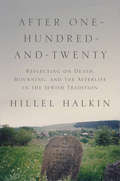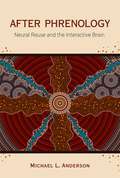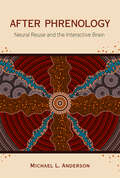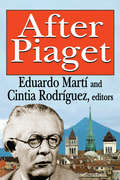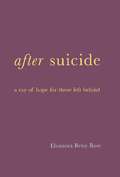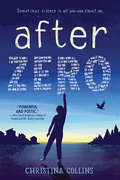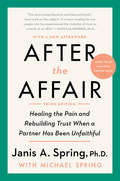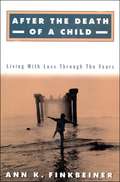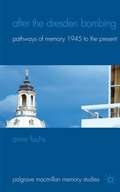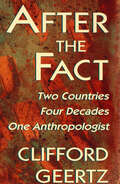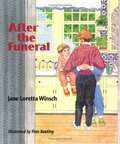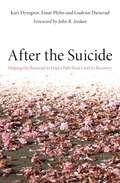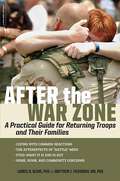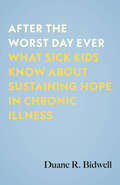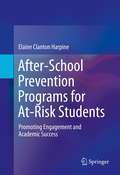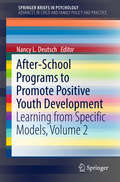- Table View
- List View
After One-Hundred-and-Twenty: Reflecting on Death, Mourning, and the Afterlife in the Jewish Tradition
by Hillel HalkinAfter One-Hundred-and-Twenty provides a richly nuanced and deeply personal look at Jewish attitudes and practices regarding death, mourning, and the afterlife as they have existed and evolved from biblical times to today. Taking its title from the Hebrew and Yiddish blessing to live to a ripe old age--Moses is said to have been 120 years old when he died--the book explores how the Bible's original reticence about an afterlife gave way to views about personal judgment and reward after death, the resurrection of the body, and even reincarnation. It examines Talmudic perspectives on grief, burial, and the afterlife, shows how Jewish approaches to death changed in the Middle Ages with thinkers like Maimonides and in the mystical writings of the Zohar, and delves into such things as the origins of the custom of reciting Kaddish for the deceased and beliefs about encountering the dead in visions and dreams.After One-Hundred-and-Twenty is also Hillel Halkin's eloquent and disarmingly candid reflection on his own mortality, the deaths of those he has known and loved, and the comfort he has and has not derived from Jewish tradition.
After Phrenology
by Michael L. AndersonThe computer analogy of the mind has been as widely adopted in contemporary cognitive neuroscience as was the analogy of the brain as a collection of organs in phrenology. Just as the phrenologist would insist that each organ must have its particular function, so contemporary cognitive neuroscience is committed to the notion that each brain region must have its fundamental computation. In After Phrenology, Michael Anderson argues that to achieve a fully post-phrenological science of the brain, we need to reassess this commitment and devise an alternate, neuroscientifically grounded taxonomy of mental function. Anderson contends that the cognitive roles played by each region of the brain are highly various, reflecting different neural partnerships established under different circumstances. He proposes quantifying the functional properties of neural assemblies in terms of their dispositional tendencies rather than their computational or information-processing operations. Exploring larger-scale issues, and drawing on evidence from embodied cognition, Anderson develops a picture of thinking rooted in the exploitation and extension of our early-evolving capacity for iterated interaction with the world. He argues that the multidimensional approach to the brain he describes offers a much better fit for these findings, and a more promising road toward a unified science of minded organisms.
After Phrenology: Neural Reuse and the Interactive Brain
by Michael L. AndersonA proposal for a fully post-phrenological neuroscience that details the evolutionary roots of functional diversity in brain regions and networks.The computer analogy of the mind has been as widely adopted in contemporary cognitive neuroscience as was the analogy of the brain as a collection of organs in phrenology. Just as the phrenologist would insist that each organ must have its particular function, so contemporary cognitive neuroscience is committed to the notion that each brain region must have its fundamental computation. In After Phrenology, Michael Anderson argues that to achieve a fully post-phrenological science of the brain, we need to reassess this commitment and devise an alternate, neuroscientifically grounded taxonomy of mental function. Anderson contends that the cognitive roles played by each region of the brain are highly various, reflecting different neural partnerships established under different circumstances. He proposes quantifying the functional properties of neural assemblies in terms of their dispositional tendencies rather than their computational or information-processing operations. Exploring larger-scale issues, and drawing on evidence from embodied cognition, Anderson develops a picture of thinking rooted in the exploitation and extension of our early-evolving capacity for iterated interaction with the world. He argues that the multidimensional approach to the brain he describes offers a much better fit for these findings, and a more promising road toward a unified science of minded organisms.
After Piaget
by Eduardo MartiAfter Piaget proves that Jean Piaget's work is critical for understanding some of the most current proposals in the study of psychological development. It analyzes Piaget's legacy, moving beyond the harsh critiques that have circulated since he lost prominence. It also brings together new developments and research practices that have grown out of Jean Piaget's tradition, while providing a retrospective glance into the intellectual atmospheres of different periods at which the contributors encountered Piaget.This book reveals the richness and coherence of the School of Geneva's research during the last decades before Piaget's death. Contributions from scholars who formed part of the School of Geneva during the 1970s and '80s demonstrate Piaget's influence on such diverse fields as infant development, ethnology, neuropsychology, semiotic development, and epistemology. After Piaget is part of Transaction's History and Theory of Psychology series.
After Sex?: On Writing Since Queer Theory
by Janet Halley Andrew ParkerSince queer theory originated in the early 1990s, its insights and modes of analysis have been taken up by scholars across the humanities and social sciences. In After Sex? prominent contributors to the development of queer studies offer personal reflections on the field's history, accomplishments, potential, and limitations. They consider the purpose of queer theory and the extent to which it is or is not defined by its engagement with sex and sexuality. For many of the contributors, a broad notion of sexuality is essential to queer thought. At the same time, some of them caution against creating an all-embracing idea of queerness, because it empties the term "queer" of meaning and assumes the universality of ideas developed in the North American academy. Some essays recall the political urgency of the late 1980s and early 1990s, when gay and lesbian activist and queer theory projects converged in response to the AIDS crisis. Other pieces exemplify more recent trends in queer critique, including the turn to affect and the debates surrounding the "antisocial thesis," which associates queerness with the repudiation of heteronormative forms of belonging. Contributors discuss queer theory's engagement with questions of transnationality and globalization, temporality and historical periodization. Meditating on the past and present of queer studies, After Sex? illuminates its future. Contributors. Lauren Berlant, Leo Bersani, Michael Cobb, Ann Cvetkovich, Lee Edelman, Richard Thompson Ford, Carla Freccero, Elizabeth Freeman, Jonathan Goldberg, Janet Halley, Neville Hoad, Joseph Litvak, Heather Love, Michael Lucey, Michael Moon, Jos Esteban Muoz, Jeff Nunokawa, Andrew Parker, Elizabeth A. Povinelli, Richard Rambuss, Erica Rand, Bethany Schneider, Eve Kosofsky Sedgwick, Kate Thomas
After Suicide: A Ray of Hope for Those Left Behind
by Eleanora Betsy RossAn extraordinary book that is a must for all people who have suffered or those who wish to support and counsel the bereaved. -Ari Kiev, M. D. , J. D. , author of A Strategy for Daily Living
After Winnicott: Compilation of Works Based on the Life, Writings and Ideas of D.W. Winnicott
by Harry KarnacThis bibliography is based on the plethora of ideas introduced into the psychoanalytic lexicon by Donald Woods Winnicott. It demonstrates amply how wide the range is of Winnicott scholarship and facilitates post-Freudian Bion and Winnicott studies.
After Zero
by Christina Collins<p>Elise carries a notebook full of tallies, each page marking a day spent at her new public school, each stroke of her pencil marking a word spoken. A word that can't be taken back. Five tally marks isn't so bad. Two is pretty good. But zero? Zero is perfect. Zero means no wrong answers called out in class, no secrets accidentally spilled, no conversations to agonize over at night when sleep is far away. <p>But now months have passed, and Elise isn't sure she could speak even if she wanted to—not to keep her only friend, Mel, from drifting further away—or to ask if anyone else has seen her English teacher's stuffed raven come to life. Then, the discovery of a shocking family secret helps Elise realize that her silence might just be the key to unlocking everything she's ever hoped for...</p>
After the Affair
by Janis A. SpringFor the 70 percent of couples who have been affected by extramarital affairs, this is the only book to offer proven strategies for surviving the crisis and rebuilding the relationship -- written by a nationally known therapist considered an expert on infidelity. When I was 15, I was raped. That was nothing compared to your affair. The rapist was a stranger; you, I thought, were my best friend. There is nothing quite like the pain and shock caused when a partner has been unfaithful. The hurt partner often experiences a profound loss of self-respect and falls into a depression that can last for years. For the relationship, infidelity is often a death blow. After the Affair is the first book to help readers survive this crisis. Written by a clinical psychologist who has been treating distressed couples for 22 years, it guides both hurt and unfaithful partners through the three stages of healing: Normalizing feelings, deciding whether to recommit and revitalizing the relationship. It provides proven, practical advice to help the couple change their behavior toward each other, cultivate trust and forgiveness and build a healthier, more conscious intimate partnership.
After the Affair
by Janis Abrahms Spring Michael SpringFor the 70 percent of couples who have been affected by extramarital affairs, this is the only book to offer proven strategies for surviving the crisis and rebuilding the relationship –– written by a nationally known therapist considered an expert on infidelity. When I was 15, I was raped. That was nothing compared to your affair. The rapist was a stranger; you, I thought, were my best friend. There is nothing quite like the pain and shock caused when a partner has been unfaithful. The hurt partner often experiences a profound loss of self–respect and falls into a depression that can last for years. For the relationship, infidelity is often a death blow. After the Affair is the first book to help readers survive this crisis. Written by a clinical psychologist who has been treating distressed couples for 22 years, it guides both hurt and unfaithful partners through the three stages of healing: Normalizing feelings, deciding whether to recommit and revitalizing the relationship. It provides proven, practical advice to help the couple change their behavior toward each other, cultivate trust and forgiveness and build a healthier, more conscious intimate partnership.
After the Affair, Third Edition: Healing the Pain and Rebuilding Trust When a Partner Has Been Unfaithful
by Janis A. Spring“Full of juicy, concrete advice to heal from an affair.” —Esther Perel, MA, LMFT, New York Times bestselling author of Mating in Captivity and The State of AffairsFrom a clinical psychologist who served as a clinical supervisor in the Department of Psychology at Yale University, received the CPA’s award for Distinguished Contribution to the Practice of Psychology, and has treated couples and trained therapists for over four decades, this newly updated, award-winning book provides concrete, proven strategies for those who seek to survive their partner’s infidelity and to rebuild the relationship after an affairThere is nothing quite like the devastation caused when a partner has been unfaithful. Hurt partners often experience a profound shattering of their familiar and valued sense of self and fall into a depression that can last for years. For the relationship, infidelity is often a death blow.This new third edition of After the Affair, with more than 600,000 copies sold, helps guide both hurt and unfaithful partners through three stages of healing: normalizing the crisis, deciding whether to recommit to their partner, and rekindling trust and sexual intimacy. It includes a new section in which patients ask questions not addressed in previous editions, and the author provides concrete strategies for earning trust and forgiveness.
After the Death of a Child
by Ann K. FinkbeinerFor a parent, losing a child is the most devastating event that can occur. Most books on the subject focus on grieving and recovery, but as most parents agree, there is no recovery from such a loss. This book examines the continued love parents feel for their child and the many poignant and ingenious ways they devise to preserve the bond. Through detailed profiles of parents, Ann Finkbeiner shows how new activities and changed relationships with their spouse, friends, and other children can all help parents preserve a bond with the lost child. Based on extensive interviews and grief research, Finkbeiner explains how parents have changed five to twenty-five years after the deaths of their children. The first half of the book discusses the short- and long-term effects of the child's death on the parent's relationships with the outside world, that is, with their spouses, other children, friends, and relatives. The second half of the book details the effect on the parents' internal world: their continuing sense of guilt; their need to place the death in some larger context and their inability sometimes to consistently do so; their new set of priorities; the nature of their bond with the lost child and the subtle and creative ways they have of continuing that bond. Finkbeiner's central point is not so much how parents grieve for their children, but how they love them. Refusing to fall back on pop jargon about "recovery" or to offer easy solutions or standardized timelines, Finkbeiner's is a genuine and moving search to come to terms with loss. Her complex profiles of parents resonate with the honesty and authenticity of uncomfortable emotions expressed and, most importantly, shared with others experiencing a similar loss. Finally, each profile exemplifies the many heroic ways parents learn to live with their pain, and by so doing, honor the lives their children should have lived.
After the Death of a Child: Living with the Loss Through the Years
by Ann K. FinkbeinerFor a parent, losing a child is the most devastating event that can occur. Most books on the subject focus on grieving and recovery, but as most parents agree, there is no recovery from such a loss. This book examines the continued love parents feel for their child and the many poignant and ingenious ways they devise to preserve the bond. Through detailed profiles of parents, Ann Finkbeiner shows how new activities and changed relationships with their spouse, friends, and other children can all help parents preserve a bond with the lost child. Based on extensive interviews and grief research, Finkbeiner explains how parents have changed five to twenty-five years after the deaths of their children. The first half of the book discusses the short- and long-term effects of the child's death on the parent's relationships with the outside world, that is, with their spouses, other children, friends, and relatives. The second half of the book details the effect on the parents' internal world: their continuing sense of guilt; their need to place the death in some larger context and their inability sometimes to consistently do so; their new set of priorities; the nature of their bond with the lost child and the subtle and creative ways they have of continuing that bond. Finkbeiner's central point is not so much how parents grieve for their children, but how they love them. Refusing to fall back on pop jargon about "recovery" or to offer easy solutions or standardized timelines, Finkbeiner's is a genuine and moving search to come to terms with loss. Her complex profiles of parents resonate with the honesty and authenticity of uncomfortable emotions expressed and, most importantly, shared with others experiencing a similar loss. Finally, each profile exemplifies the many heroic ways parents learn to live with their pain, and by so doing, honor the lives their children should have lived.
After the Dresden Bombing
by Anne FuchsTogether with Hiroshima and Nagasaki, Dresden belongs to a handful of global icons that capture the destructiveness of warfare in the twentieth century. Immediately recognisable, these icons are endowed with a powerful symbolism that cannot be explained with reference to historical cause and effect alone. This is precisely the terrain of this book, whichaddresses the long aftermath of the bombing in the collective and cultural imagination from 1945 to the present. The material under discussion ranges from archival documents, architectural journals, the built environment, travelogues, newspaper articles, documentaries, TV dramas, fiction, diaries, poetry to photography and fine art. As a case study of an event that gained local, national and global iconicity in the postwar period, it illuminates the media-specific transmission of cultural memory in dialogue with the changing socio-political landscape. Debating fundamental processes of cultural transmission, it exemplifies a new mode of doing cultural history that interweaves the local and the global. "
After the Eclipse: A Mother's Murder, A Daughter's Search
by Sarah Perry"Stunning." —Entertainment Weekly | "Raw and perfect." —Laura Miller, Slate"Heartbreaking yet hopeful." —Samantha Irby, Marie Claire A fierce memoir of a mother’s murder, a daughter’s coming-of-age in the wake of immense loss, and her mission to know the woman who gave her life. When Sarah Perry was twelve, she saw a partial eclipse of the sun, an event she took as a sign of good fortune for her and her mother, Crystal. But that brief moment of darkness ultimately foreshadowed a much larger one: two days later, Crystal was murdered in their home in rural Maine, just a few feet from Sarah’s bedroom. The killer escaped unseen; it would take the police twelve years to find him, time in which Sarah grew into adulthood, struggling with abandonment, police interrogations, and the effort of rebuilding her life when so much had been lost. Through it all she would dream of the eventual trial, a conviction—all her questions finally answered. But after the trial, Sarah’s questions only grew. She wanted to understand her mother’s life, not just her final hours, and so she began a personal investigation, one that drew her back to Maine, taking her deep into the abiding darkness of a small American town. Told in searing prose, After the Eclipse is a luminous memoir of uncomfortable truth and terrible beauty, an exquisite memorial for a mother stolen from her daughter, and a blazingly successful attempt to cast light on her life once more.
After the Fact: Two Countries, Four Decades, One Anthropologist (The Jerusalem-Harvard Lectures #5)
by Clifford Geertz“An unabashedly honest ethnography . . . [from] a founder of ‘symbolic’ anthropology . . . reflections on his fieldwork over a period of . . . forty years. Brilliant.” (Kirkus Reviews) In looking back on four decades of anthropology in the field, Geertz has created a work that is a personal history as well as a retrospective reflection on developments in the human sciences amid political, social, and cultural changes in the world. An elegant summation of one of the most remarkable careers in anthropology, it is at the same time an eloquent statement of the purposes and possibilities of anthropology's interpretive powers.Through the prism of his fieldwork over forty years in two towns, Pare in Indonesia and Sefrou in Morocco, Geertz adopts various perspectives on anthropological research and analysis during the post-colonial period, the Cold War, and the emergence of the new states of Asia and Africa. Throughout, he clarifies his own position on a broad series of issues at once empirical, methodological, theoretical, and personal. The result is a truly original book, one that displays a particular way of practicing the human sciences and thus a particular—and particularly efficacious—view of what these sciences are, have been, and should become.“Geertz charts the transformation of cultural anthropology from a study of "primitive" people to a multidisciplinary investigation of a particular culture's symbolic systems, its interactions with the larger forces of history and modernization.” —Publishers Weekly“An elegant, almost meditative volume of reflections.” —The New Yorker“[An] engrossing story of a few key moments in American social science during the second half of the twentieth century as [Geetz] participated in them.” —New York Times Book Review
After the Funeral
by Jane Loretta WinschThe strange and disturbing new feelings that grief brings are frightening and stressful for children. And although most parents might feel prepared to deal with the anger, sadness, and loneliness that accompany the loss of a loved one, they might not feel quite as prepared to deal with children's other less obvious, yet equally predominant, feelings of embarrassment, fear, and inadequacy. AFTER THE FUNERAL offers some very real help to parents, teachers, and other caring adults in dealing with the complex reactions that children have to a loss. Its simple format encourages honest dialogue and compassionately helps children to recognize some of the raw feelings of grief--and then confront it honestly. After the Funeral is a positive contribution that will help children and their families move forward towards acceptance, understanding, and hope.
After the Suicide
by Kari Dyregrov Einar Plyhn Gudrun Dieserud*Highly Commended in the Health and Social Care category at the 2012 British Medical Association Book Awards*Those left behind in the wake of suicide are often plagued by unanswered questions and feelings of guilt. Helping them to understand why the suicide happened, how suicide survivors commonly react and cope, and where they can find support can help them move forwards on their path from grief to recovery. Drawing on the testimonies of suicide survivors and research into suicide bereavement, this book provides those working with the bereaved with the knowledge and guidance they need. It covers common grief and crisis reactions, including those specific to children and young people, how suicide bereavement differs from other forms of bereavement, and how others have coped and been supported. It also addresses how the bereaved can move on, including advice on support networks including friends, family, professionals and other bereaved people. This book will be invaluable to all those supporting those who have been bereaved by suicide, including counsellors, bereavement support workers, social workers, and psychologists.
After the War Zone: A Practical Guide for Returning Troops and Their Families
by Matthew J. Friedman Laurie B. SloneTwo experts from the VA National Center for PTSD provide an essential resource for service members, their spouses, families, and communities, sharing what troops really experience during deployment and back home. Pinpointing the most common after-effects of war and offering strategies for troop reintegration to daily life, Drs. Friedman and Slone cover the myths and realities of homecoming; reconnecting with spouse and family; anger and adrenaline; guilt and moral dilemmas; and PTSD and other mental-health concerns. With a wealth of community and government resources, tips, and suggestions, <i>After the War Zone</i> is a practical guide to helping troops and their families prevent war zone stresses from having a lasting negative impact.
After the Worst Day Ever: What Sick Kids Know About Sustaining Hope in Chronic Illness
by Duane R. BidwellFor those who care for chronically ill children, a new understanding of hope that equips adults to better nurture pediatric hope among sick kids—articulated by the children themselvesAs anyone with a chronic illness knows, hope can sometimes be hard to come by. For parents and caregivers of children with serious illness, there can be a real struggle to move beyond one's own grief, fear, and suffering to see what hope means for these kids.Duane Bidwell, a scholar, minister, and former hospital chaplain who has struggled with serious illness himself, spent time with 48 chronically ill children in dialysis units and transplant clinics around the United States. Chronically ill kids, he found, don&’t adhere to popular or scholarly understandings of hope. They experience hope as a sense of well-being in the present, not a promise of future improvement, an ability to set goals, or the absence of illness and suffering. With this mindset, these kids suggest a new understanding of pediatric hope, saying hope becomes concrete when they (1) realize community, (2) claim power, (3) attend to Spirit, (4) choose trust, and (5) maintain identity.Offering textured portraits of children with end-stage kidney disease, After the Worst Day Ever illustrates in their words how sick children experience, maintain, and turn toward hope even when illness cannot be cured and severely limits quality of life. Their insights reveal how the adults in a sick child's world—parents, chaplains, medical professionals, teachers, and others—can nurture hope. They also shift our understanding of hope from an internal resource located &“inside&” an individual to a shared, communal experience that becomes a resource for individuals.Rich and moving, Bidwell&’s work helps us imagine anew what it means to sustain hope despite inescapable suffering and the limits of chronic illness.
After-School Centers and Youth Development
by Nancy L. Deutsch David L. Dubois Barton J. HirschThis book examines after-school programs in light of their explosive growth in recent years. In the rush to mount programs, there is a danger of promoting weak ones of little value and failing to implement strong ones adequately. But what is quality and how can it be achieved? This book presents findings from an intensive study of three after-school centers that differed dramatically in quality. Drawing from 233 site visits, the authors examine how - and why - young people thrive in good programs and suffer in weak ones. The book features engaging, in-depth case studies of each of the three centers and of six youths, two from each center. Written in a highly accessible style for academics, youth workers, after-school program leaders and policy makers, the study breaks new ground in highlighting the importance of factors such as collective mentoring, synergies among different programs and activities, and organizational culture and practices.
After-School Prevention Programs for At-Risk Students: Promoting Engagement and Academic Success
by Elaine Clanton HarpineAfter-School Prevention Programs for At-Risk Students offers professionals a detailed framework for developing and enhancing after-school programs. Emphasizing a prevention focus and a group-centered interactive approach, the book's year-long model combines education and counseling, incorporating key therapeutic objectives to foster academic and behavior skills and reduce problems in and outside class. Practical step-by-step guidelines for creating and implementing programs include clear rationales, instructive design and case examples, and ready-to-use interventions. The author also provides guidance on developmental, gender, and cultural considerations, the challenges of maintaining progress over the course of the school year, and the handling of severe learning and emotional problems. Among the topics covered: Organizing a group-centered after-school program.Combining learning and counseling into one curriculum.The role of motivation in an ongoing year-long program.Group process, self-efficacy, cohesion: applying the principles of change.Interaction in a year-long program.Solving problems and conflicts. After-School Prevention Programs for At-Risk Students is an essential reference for scientist-practitioners, clinicians, and academics in such disciplines as school psychology, childhood education, social work, psychotherapy and counseling, and learning and instruction.
After-School Programming and Intrinsic Motivation: Teaching At-Risk Students to Read
by Elaine Clanton HarpineThis book examines the eight-year development of the Reading Orienteering Club after-school program, showing how to develop, test, change, and adapt an after-school program to fit the needs of the children who attend. It includes case studies and data reports for each year and presents the theory, application, and program evaluation steps that workers in the field or students learning about program design must follow. Chapters present first-person accounts as well as statistical evaluations of the effectiveness of the reading program with each group of children. In addition, chapters highlight the changes that were made in program design and why each change was implemented, giving practitioners the insights needed to adapt interventions and strategies to their own programs. The book concludes with recommendations from the authors on how to run a successful after-school reading program. Topics featured in this book include:The effect of intrinsic motivation to mental wellness in the classroom.The importance of oral reading in correcting reading failure.Group-center approaches to teaching reading in the classroom.How to select the best evaluation tool.The challenges of mixing inner city and rural students in a reading program. After-School Programming and Intrinsic Motivation is an essential reference for scientist-practitioners, clinicians, researchers, and graduate students in such disciplines as school psychology, childhood education, social work, psychotherapy and counseling, and learning and instruction.
After-School Programs to Promote Positive Youth Development: Integrating Research into Practice and Policy, Volume 1 (SpringerBriefs in Psychology)
by Nancy L. DeutschThe first volume of this SpringerBrief presents a series of papers compiled from a conference about how after-school programs may be implemented to promote positive youth development (PYD) hosted by Youth-Nex, the University of Virginia Center to Promote Effective Youth Development. This volume reviews the importance of after-school programs for PYD and discusses key components of effective after-school programs. It also discusses issues related to the evaluation and measurement of quality in after-school programs. In addition, the brief presents suggestions for how researchers, policy makers, and practitioners can move the field forward and maximize the potential of after-school time and programs for promoting positive youth development for children and adolescents. Topics featured in this brief include: The history of the relationship between after-school programs and positive youth development. Specific features of programs that are important for advancing positive youth development. Issues in and approaches to measuring quality in after-school programs. The Quality, Engagement, Skills, Transfer (QuEST) model and its use for measuring effective after-school programs. A case study evaluation of the Girls on the Run program. After-School Programs to Promote Positive Youth Development, Volume 1, is a must-have resource for policy makers and related professionals, graduate students, and researchers in child and school psychology, family studies, public health, social work, law/criminal justice, and sociology.
After-School Programs to Promote Positive Youth Development: Learning from Specific Models, Volume 2 (SpringerBriefs in Psychology)
by Nancy L. DeutschThe first volume of this SpringerBrief presents a series of papers compiled from a conference about how after-school programs may be implemented to promote positive youth development (PYD) hosted by Youth-Nex, the University of Virginia Center to Promote Effective Youth Development. This volume reviews the importance of after-school programs for PYD and discusses key components of effective after-school programs. It also discusses issues related to the evaluation and measurement of quality in after-school programs. In addition, the brief presents suggestions for how researchers, policy makers, and practitioners can move the field forward and maximize the potential of after-school time and programs for promoting positive youth development for children and adolescents. Topics featured in this brief include: The history of the relationship between after-school programs and positive youth development. Specific features of programs that are important for advancing positive youth development. Issues in and approaches to measuring quality in after-school programs. The Quality, Engagement, Skills, Transfer (QuEST) model and its use for measuring effective after-school programs. A case study evaluation of the Girls on the Run program. After-School Programs to Promote Positive Youth Development, Volume 1, is a must-have resource for policy makers and related professionals, graduate students, and researchers in child and school psychology, family studies, public health, social work, law/criminal justice, and sociology.
